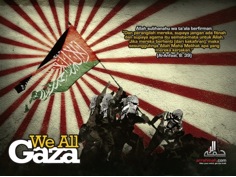
along with an "Image Analysis" such as:
The dominant element of the image is the red rays, which are significant, as red is the color of fire, blood, passion, impulse and danger. Light rays are often used to illuminate other symbols or text in an image to give them an aura of divinity and/or afterlife. At the center of the rays is a Palestinian flag that bears the shahada (Islamic testimony of faith holding that there is no god but Allah and that Muhammad is his messenger). The flag is held by a group of men, identified as fighters by the fact that their faces are covered by the kafiyya (head scarf). The text is a Qur’anic quote (Q 8:39), written in Indonesian.
It seems that the image, via the posture of the soldiers and the way they are holding the flag, is trying to imitate the famous United States Marine Corps War Memorial (also known as the Iwo Jima Memorial), located in Arlington, Virginia. By doing so, the image evokes notions of bravery and sacrifice on the battlefield and absolute commitment to the mission/struggle.
The larger purposes of the Project are described by the CTC like this:
The use of propaganda and imagery by terrorist groups has long been an understudied dimension of the broader field of political violence. This project explores the use of imagery and visual themes by militant groups, focusing largely on jihadist media production. Jihadist organizations and individuals inspired by their message are prolific producers and distributors of visual propaganda, and their efforts have expanded exponentially online. However, these images frequently utilize themes which can be inscrutable to those not familiar with the sub-culture. It is our hope that this project will provide academics, practitioners, and students with a basic contextual understanding of the ideas these images convey before they turn to the larger questions of why they are employed, how they work, and what responses they may elicit.
The First Edition of this project was completed in 2006. The second phase (2010-2013) included indexing the project’s initial images, expanding and incorporating new images, and putting all of the images online in a searchable format. Particular attention was given to groups who use images to further financial, material, and ideological support for violence. The imagery dataset provides not just a textual analysis, but also full translation, if texts are part of the image, and a search engine for those interested in specific visual motifs. While by no means an exhaustive list, we feel it provides a sample of the most influential and prominent images and themes. We hope it will serve as a useful tool for practitioners, academics and the general public. Contingent upon funding and interest, we hope to update the dataset to highlight visual themes of additional militant groups in the future.

No comments:
Post a Comment
Note: Only a member of this blog may post a comment.